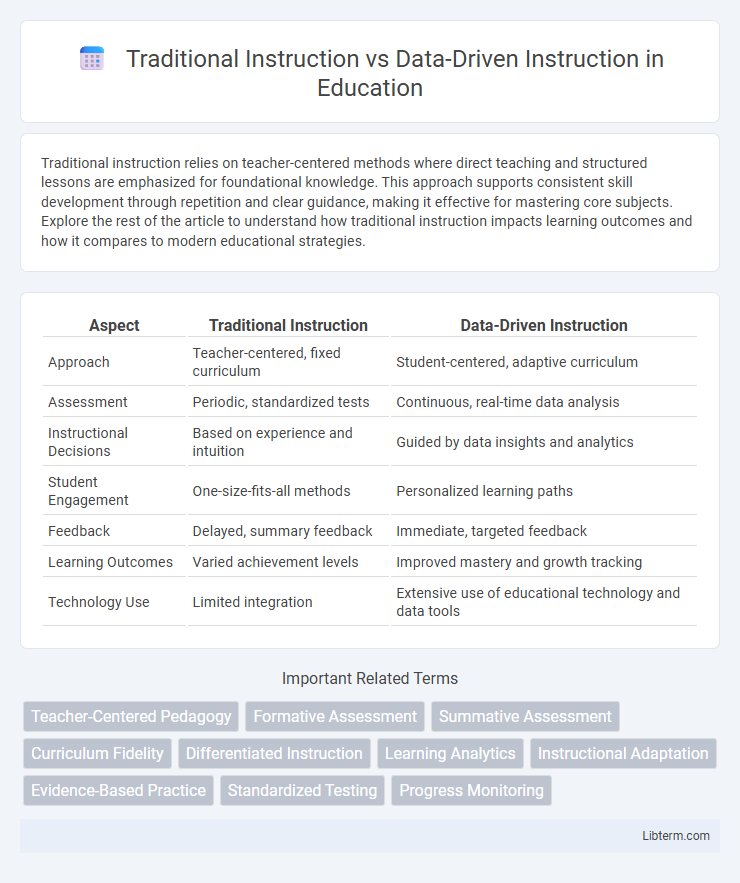Traditional instruction relies on teacher-centered methods where direct teaching and structured lessons are emphasized for foundational knowledge. This approach supports consistent skill development through repetition and clear guidance, making it effective for mastering core subjects. Explore the rest of the article to understand how traditional instruction impacts learning outcomes and how it compares to modern educational strategies.
Table of Comparison
| Aspect | Traditional Instruction | Data-Driven Instruction |
|---|---|---|
| Approach | Teacher-centered, fixed curriculum | Student-centered, adaptive curriculum |
| Assessment | Periodic, standardized tests | Continuous, real-time data analysis |
| Instructional Decisions | Based on experience and intuition | Guided by data insights and analytics |
| Student Engagement | One-size-fits-all methods | Personalized learning paths |
| Feedback | Delayed, summary feedback | Immediate, targeted feedback |
| Learning Outcomes | Varied achievement levels | Improved mastery and growth tracking |
| Technology Use | Limited integration | Extensive use of educational technology and data tools |
Understanding Traditional Instruction
Traditional instruction emphasizes teacher-led lessons, structured curricula, and standardized assessments to deliver content systematically. It relies heavily on direct instruction methods, where educators control the pace and sequence of learning based on predetermined objectives. This approach often prioritizes memorization and repetition over personalized feedback and real-time data adaptation.
What is Data-Driven Instruction?
Data-Driven Instruction (DDI) leverages student performance data to tailor teaching methods and improve learning outcomes. By analyzing assessment results, educators identify strengths and weaknesses, enabling targeted interventions and personalized lesson plans. This approach contrasts with traditional instruction, which often relies on a fixed curriculum without continuous adjustments based on real-time student data.
Key Differences Between Traditional and Data-Driven Instruction
Traditional instruction relies heavily on teacher intuition and standardized curricula, often emphasizing rote learning and fixed lesson plans. Data-driven instruction utilizes real-time student performance metrics and analytics to tailor lessons, promoting personalized learning and continuous assessment. This approach prioritizes adaptive teaching strategies based on measurable outcomes, contrasting with the one-size-fits-all method of traditional classrooms.
Strengths of Traditional Teaching Methods
Traditional teaching methods excel in fostering direct teacher-student interaction, which supports personalized guidance and immediate feedback. These approaches build strong foundational skills through structured lessons, clear objectives, and consistent routines. Emphasis on hands-on activities and face-to-face communication enhances student engagement and social development in classroom settings.
Advantages of Data-Driven Instructional Approaches
Data-driven instructional approaches enable educators to tailor teaching strategies based on real-time student performance data, enhancing personalized learning experiences and improving academic outcomes. By continuously analyzing assessment results, educators can identify learning gaps and adjust interventions promptly, leading to increased student engagement and achievement. This method fosters evidence-based decision-making, promoting efficient resource allocation and targeted support for diverse learner needs.
Challenges with Traditional Instruction
Traditional instruction often relies on a one-size-fits-all approach that fails to address individual student needs, leading to varied learning outcomes. Limited use of formative assessment data restricts timely feedback and adaptation of teaching strategies. This approach can result in reduced student engagement and missed opportunities for personalized learning interventions.
Limitations of Data-Driven Instruction
Data-driven instruction faces limitations such as overreliance on standardized test scores, which may not capture the full spectrum of student abilities or creativity. It often underestimates contextual factors like socioeconomic status or emotional well-being that significantly influence learning. This approach can also lead to teaching to the test, reducing opportunities for critical thinking and personalized learning experiences.
Impact on Student Outcomes
Traditional instruction often relies on uniform teaching methods, which may not address diverse student needs, limiting overall academic achievement. Data-driven instruction leverages real-time analytics and assessment data to tailor lessons, resulting in significant improvements in student engagement and test scores. Research from the Institute of Education Sciences indicates that data-driven approaches can boost student learning outcomes by up to 20%.
Integrating Traditional and Data-Driven Strategies
Integrating traditional instruction with data-driven strategies enhances teaching effectiveness by combining proven pedagogical methods with real-time performance insights. Utilizing student assessment data allows educators to tailor lesson plans while maintaining foundational instructional techniques. This blended approach supports differentiated learning and improves academic outcomes through targeted interventions.
Future Trends in Educational Instruction
Future trends in educational instruction emphasize the integration of data-driven methods over traditional instruction, leveraging real-time analytics to personalize learning experiences and improve outcomes. Adaptive learning technologies powered by artificial intelligence enable educators to tailor content dynamically based on student performance and engagement metrics. The shift towards data-driven instruction fosters continuous feedback loops, enhancing curriculum design and promoting evidence-based teaching strategies for diverse learning needs.
Traditional Instruction Infographic

 libterm.com
libterm.com